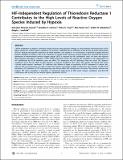| dc.contributor.author | Naranjo-Suarez, Salvador | |
| dc.contributor.author | Carlson, Bradley A. | |
| dc.contributor.author | Tsuji, Petra A. | |
| dc.contributor.author | Yoo, Min-Hyuk | |
| dc.contributor.author | Gladyshev, Vadim | |
| dc.contributor.author | Hatfield, Dolph L. | |
| dc.date.accessioned | 2012-05-01T17:00:53Z | |
| dc.date.issued | 2012 | |
| dc.identifier.citation | Naranjo-Suarez, Salvador, Bradley A. Carlson, Petra A. Tsuji, Min-Hyuk Yoo, Vadim N. Gladyshev, and Dolph L. Hatfield. 2012. HIF-independent regulation of thioredoxin reductase 1 contributes to the high levels of reactive oxygen species induced by hypoxia. PLoS ONE 7(2): e30470. | en_US |
| dc.identifier.issn | 1932-6203 | en_US |
| dc.identifier.uri | http://nrs.harvard.edu/urn-3:HUL.InstRepos:8645494 | |
| dc.description.abstract | Cellular adaptation to hypoxic conditions mainly involves transcriptional changes in which hypoxia inducible factors (HIFs) play a critical role. Under hypoxic conditions, HIF protein is stabilized due to inhibition of the activity of prolyl hydroxylases (EGLNs). Because the reaction carried out by these enzymes uses oxygen as a co-substrate it is generally accepted that the hypoxic inhibition of EGLNs is due to the reduction in oxygen levels. However, several studies have reported that hypoxic generation of mitochondrial reactive oxygen species (ROS) is required for HIF stabilization. Here, we show that hypoxia downregulates thioredoxin reductase 1 (TR1) mRNA and protein levels. This hypoxic TR1 regulation is HIF independent, as HIF stabilization by EGLNs inhibitors does not affect TR1 expression and HIF deficiency does not block TR1 hypoxic-regulation, and it has an effect on TR1 function, as hypoxic conditions also reduce TR1 activity. We found that, when cultured under hypoxic conditions, TR1 deficient cells showed a larger accumulation of ROS compared to control cells, whereas TR1 over-expression was able to block the hypoxic generation of ROS. Furthermore, the changes in ROS levels observed in TR1 deficient or TR1 over-expressing cells did not affect HIF stabilization or function. These results indicate that hypoxic TR1 down-regulation is important in maintaining high levels of ROS under hypoxic conditions and that HIF stabilization and activity do not require hypoxic generation of ROS. | en_US |
| dc.language.iso | en_US | en_US |
| dc.publisher | Public Library of Science | en_US |
| dc.relation.isversionof | doi:10.1371/journal.pone.0030470 | en_US |
| dc.relation.hasversion | http://www.ncbi.nlm.nih.gov/pmc/articles/PMC3278416/pdf/ | en_US |
| dash.license | LAA | |
| dc.subject | biology | en_US |
| dc.subject | biochemistry | en_US |
| dc.subject | enzymes | en_US |
| dc.subject | metabolism | en_US |
| dc.subject | proteins | en_US |
| dc.subject | molecular cell biology | en_US |
| dc.subject | gene expression | en_US |
| dc.title | HIF-Independent Regulation of Thioredoxin Reductase 1 Contributes to the High Levels of Reactive Oxygen Species Induced by Hypoxia | en_US |
| dc.type | Journal Article | en_US |
| dc.description.version | Version of Record | en_US |
| dc.relation.journal | PLoS ONE | en_US |
| dash.depositing.author | Gladyshev, Vadim | |
| dc.date.available | 2012-05-01T17:00:53Z | |
| dc.identifier.doi | 10.1371/journal.pone.0030470 | * |
| dash.contributor.affiliated | Gladyshev, Vadim | |


